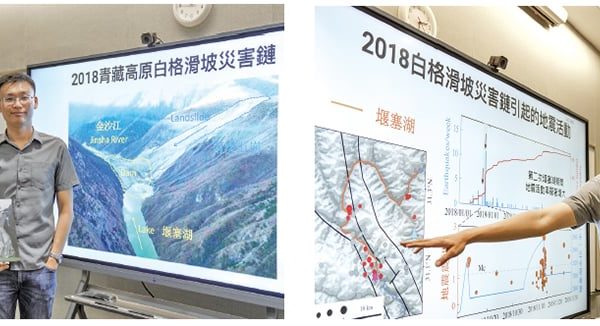An earthquake triggered a landslide, blocking the riverbed and forming a barrier lake, according to a recent international study led by the Faculty of Science at the Chinese University of Hong Kong. The research team found that apart from being a consequence of earthquakes, barrier lakes may also trigger earthquakes, confirming for the first time the interconnected relationship between surface disasters and earthquakes. Researchers believe that this discovery will help in future disaster prevention efforts following earthquakes.
In 2018, two landslides occurred in the Bai Ge region of the Qinghai-Tibet Plateau, with a total volume of 33 million cubic meters, equivalent to 13,000 Olympic-standard swimming pools, leading to the formation of a barrier lake. The team at Chinese University’s Earth and Environmental Sciences program observed that within a week of the landslides, over 60 earthquakes occurred in the area, a frequency 20 times higher than before the barrier lake formation.
The Chinese University team led an international research collaboration with Switzerland’s Federal Institute for Forest, Snow, and Landscape Research, the Institute of Mountain Hazards and Environment of the Chinese Academy of Science’s Ministry of Water Resources, and the Sichuan Earthquake Administration. Through analyzing a highly accurate earthquake catalog constructed based on artificial intelligence methods and establishing an earthquake stress triggering model, it was confirmed that the above-mentioned earthquakes were likely triggered by the gravitational loading and fluid pressure diffusion of the barrier lake.
Assistant Professor Chan Yin-cho, from the Faculty of Science’s Earth and Environmental Sciences program at Chinese University, who led the research, stated that this study has proven for the first time that earthquakes can be triggered by surface natural disasters. He explained that when landslide debris blocks a valley or riverbed to form a barrier lake, as the water level rises, the water pressure increases, leading to an increase in underground pressure. Simultaneously, the lake water will seep into underground pores, increasing pore pressure. These combined effects further trigger earthquakes by causing nearby faults to slip.
Dr. Zhang Zhen, the first author of the study and a postdoctoral researcher in the Earth and Environmental Sciences program at the Chinese University, pointed out that the results of this study are highly significant for future earthquake risk management. He cited the example of the 2008 Wenchuan earthquake in China, which triggered over 100,000 landslides and formed hundreds of barrier lakes, which may have been one of the factors contributing to subsequent earthquakes that year. This research confirms that surface natural disasters and earthquakes can be mutually causal, potentially forming a disaster cycle.
Dr. Zhang further stated that in regions prone to frequent large landslides and barrier lake formation, such as the southwestern part of China and the Himalayas where earthquake activity is high, when assessing natural disaster risks in the future, the chain reaction effect of barrier lakes triggering earthquakes may need to be considered. Especially after significant landslides occur, emergency response departments in those areas should prepare for potential earthquakes.
Dr. Liu Min, the second author of the study and a postdoctoral researcher in the Earth and Environmental Sciences program at Chinese University, mentioned that under climate warming, glacier melt will lead to an increase in the volume and weight of glacier lakes, forming structures similar to barrier lakes. Through similar mechanisms, this could also potentially trigger earthquakes, meaning that climate warming may increase the frequency of earthquakes in some high-risk areas.
Chan stated that the team will further study other regions worldwide to see if similar phenomena to the Bai Ge landslides causing earthquakes have occurred, in order to understand the scale and prevalence of such events. They will also explore the relationship between structures similar to barrier lakes, like glacial lakes, and earthquake occurrences. He added that the Bai Ge large slope has been slowly moving for decades, but suddenly collapsed in 2018, leading to the emergency evacuation of over 120,000 people. Therefore, the team hopes to further study the mechanism of sudden collapses of slow-moving large slopes, to determine if there are methods to predict catastrophic landslides.
The research results have been published in the prestigious international academic journal “Nature Communications.”

